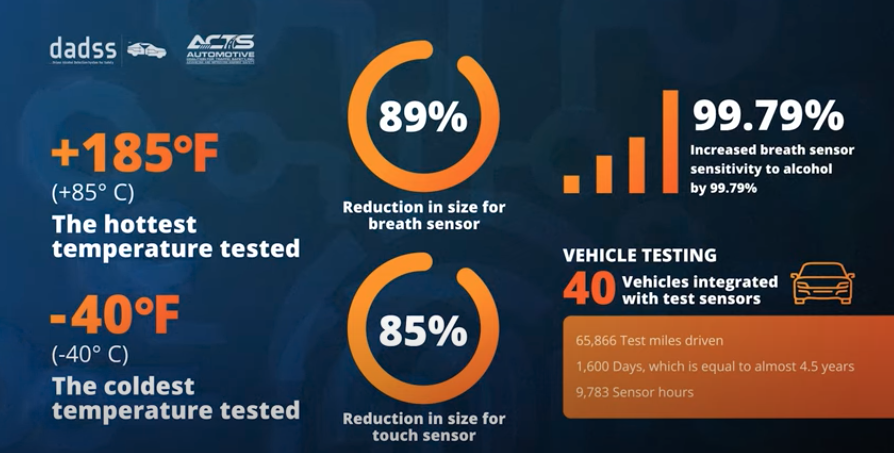Buried deep in the 2,700-page bipartisan infrastructure bill is a provision that mandates all cars manufactured from 2027 onwards be equipped with a drunk driver monitoring system, in the hopes of ending a behavior that results in about 10,000 deaths in the U.S. every year. If passed with this provision, the bill would give a firm release date to a research program the federal government and an automotive industry group have collaborated on for more than a decade.
Since 2008, an alphabet soup of acronym organizations have been working on a public-private partnership to invent a new technology that can prevent drunk driving. The National Highway Traffic Safety Administration (NHTSA) partnered with the Automotive Coalition for Traffic Safety (ACTS), an industry group representing all the major automakers, to form the Driver Alcohol Detection System for Safety Program, which goes by the unfortunate acronym of DADSS.
Videos by VICE
DADSS is working on two separate detection systems. One detects blood alcohol levels in a driver’s breath through ambient air in the car cabin, supposedly distinguishing the driver’s breath from that of any passengers. The other uses a touch sensor with infrared lights that can be incorporated into the push-start engine button to detect blood alcohol level through the skin. Both are designed to be passive monitoring systems, meaning the driver doesn’t have to do anything to be tested. If, in theory, the system detects a blood alcohol level above the legal limit, the car will not be allowed to drive, but can remain on to power the climate control or charge a phone. The technology will be open-source licensed, so any auto supplier or manufacturer can use it “on the same terms,” although it won’t be free.
Although the provision in the infrastructure bill does not specifically mention DADSS, it calls on the transportation secretary to require all passenger vehicles manufactured after 2027 to have a passive drunk and impaired driving prevention technology, a clear reference to the program.
Of course, eliminating drunk driving through a passive monitoring system sounds great in theory. The big question is whether this technology actually works. Even simple breathalyzers hooked up to car ignitions that are often court-ordered after a DUI can malfunction, and tolerance for a finicky device that occasionally prevents sober people from driving their cars would not go over well with the general public. Given such a technology would likely be used hundreds of millions of times every single day if mandated, an error rate of even .01 percent would result in millions of mistakes a day.
DADSS is currently testing what it calls the “GEN 3.3” breath sensor and says it is installing it in fleet vehicles with zero tolerance alcohol policies for drivers later this year (which may indicate the sensors cannot yet reliably distinguish between alcohol levels at or near the legal limit of .08 blood alcohol content). In a Youtube video providing an update on their research, the program says they have conducted “200 study days” in real-world conditions with 338 individuals in 40 vehicles integrated with the test sensors. DADSS predicts the next “GEN 4.0” system will be small and reliable enough to fit into consumer vehicles by 2024. The touch sensor, according to the program’s timeline estimate, is a year or so behind. There is a provision in the bill that allows the transportation secretary to delay the requirement if the technology isn’t ready.

Another question regarding the drunk driving monitoring system is user privacy. Cars are privacy nightmares, hoovering up masses of data on everything a driver does from opening the door to putting their seatbelt on to where they are going and at what speed. Law enforcement routinely gets warrants to search the data in car infotainment systems. If data on these passive drunk driving monitoring systems are housed within the car itself, it is likely police could obtain that data too.
When Motherboard asked DADSS about privacy controls for its system, spokesperson Jake McCook replied, “Legislation authorizing the DADSS program, and the cooperative agreement that NHTSA and the automakers are operating under, states specifically that operating procedures and security measures must be put in place to protect data from the inadvertent release or disclosure to authorized parties. Today, all automakers have security measures in place to protect customer data from being accessed by unauthorized parties, and DADSS standards will be no different.”
Modern cars are so integrated with other technologies and platforms that it is not always up to the car companies how secure their vehicles are. For example, earlier this year, hackers sold customer data stolen from Audi and Volkswagen which was hosted on an unsecured Microsoft Azure cloud server. Electronic key fobs have been notoriously easy to hack for years. And in 2019, a hacker gained the ability to disable car engines remotely by logging into thousands of third-party fleet monitoring platforms using the default password of “123456.”




